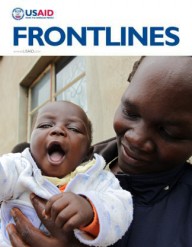Ten years ago, Afghanistan had one of the world's worst health-care systems. Most trained health professionals had left the country, and there were few functioning medical facilities.
The Taliban had effectively banned women from receiving health care. As a result, an estimated one in four children died under the age of 5, and maternal mortality was estimated to be the highest in the world—data collected at that time suggests one in 10 women died of pregnancy-related complications. Life expectancy was a meager 45 years, according to the United Nations. Afghans were dying from simple, preventable illnesses—such as diarrhea and bronchitis—that literally cost pennies to treat.
In 2002, the newly formed Afghan Government began working with USAID and other international donors to restart a viable health-care system. The effort was based on a few simple premises.
First, focus on getting low-cost, low-tech, high-impact treatments to the largest number of Afghans possible, particularly in rural areas.
Second, bring together as many partners as possible—government officials, international donors and NGOs—to support a common “blueprint” for primary care delivery and guaranteed access to care in all parts of the country.
Third, and most important, ensure Afghans could develop their own health institutions so that access to basic health care would continue in the long term.
With this approach in mind, the Afghan Government, with strong support from the U.S. Government and other donors, began to roll out a basic package of health services to millions of Afghans. As a result, access to basic health services has risen from 9 percent in 2001 to more than 60 percent today.
The results are of this effort are documented in the Afghanistan Mortality Survey 2010, the first comprehensive, national survey of key health and quality of life indicators. The findings released in late 2011 in Kabul paint a clear picture of remarkable progress.
Whereas maternal health care was effectively unavailable under the Taliban, today six in 10 women see a trained care provider during pregnancy, family sizes are down from more than six children per mother to approximately five, and skilled assistance during childbirth has more than doubled. As a result, significantly fewer women are dying from pregnancy-related causes than they did just a decade ago, and life expectancy has risen to about 62 years, up some 15-20 years from previous estimates.
While donor contributions will remain critical to the sector's viability for years to come, Afghans themselves are increasingly shouldering the financial costs of improving and expanding the health system. Government contributions to the health sector are growing and the Ministry of Public Health continues to seek ways to increase revenues and reduce cost.
This spirit of self-reliance is an important reminder of the sustainable results that development partnerships can deliver, even in places haunted by conflict: longer lives, healthier families, and the chance for children to live past their fifth birthdays. It also develops faith in government, which is critical for Afghanistan to overcome its struggle with violent extremism.
Both the Afghan Government and the international community must build on these remarkable achievements and learn from this successful partnership. During a time of continued violence and pessimism about Afghanistan's future in some quarters, tens of thousands of men, women and children who would not have survived continued Taliban rule are alive today because of the partnership between the Afghan people, health-care providers and the international community.
Despite these gains, Afghans continue to face serious challenges, and a long-term partnership between Afghanistan and the international community remains critical. One in 13 children dies before their first birthday, one in 10 children in Afghanistan dies before age five, and one Afghan woman dies from pregnancy-related causes every two hours.
As Afghans increasingly assume responsibility for their own welfare, they build on the results of generous investments from the American people and other allies, coupled with capable, dedicated Afghan leadership in the health sector. The extraordinary gains in Afghanistan's health sector over the past decade show us what is possible.
Dr. Suraya Dalil is Afghanistan’s acting minister of public health.
This article was originally published on the Foreign Policy AfPak channel.












Comment
Make a general inquiry or suggest an improvement.